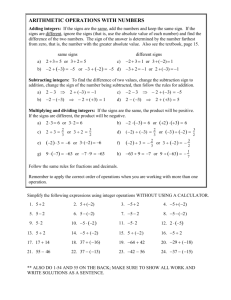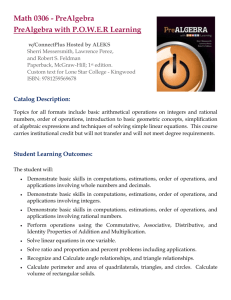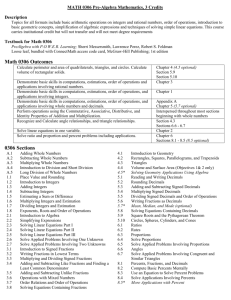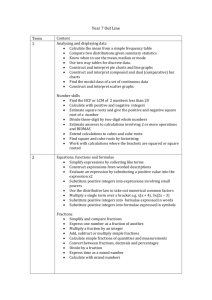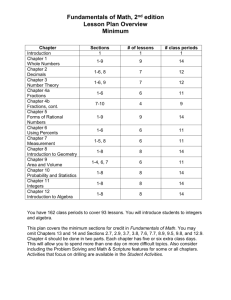Seventh Grade Pre-Algebra A Curriculum Map
advertisement
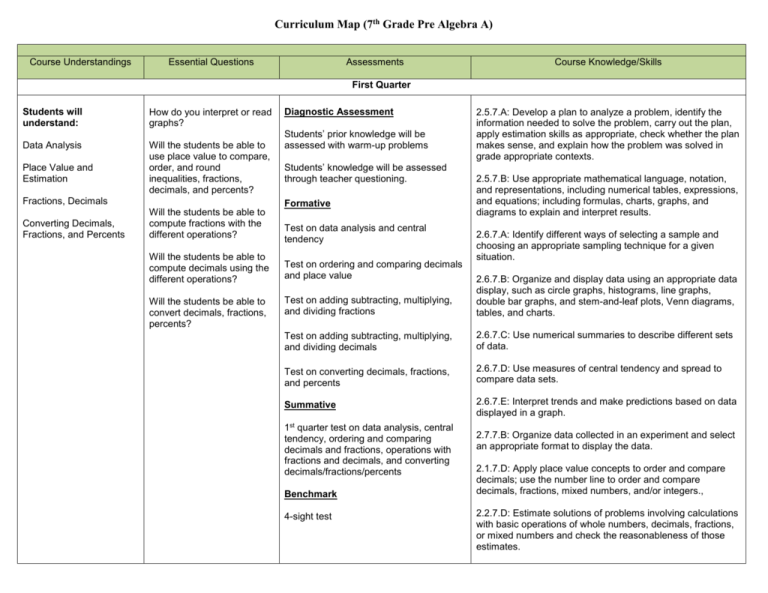
Curriculum Map (7th Grade Pre Algebra A) Course Understandings Essential Questions Assessments Course Knowledge/Skills First Quarter Students will understand: How do you interpret or read graphs? Data Analysis Will the students be able to use place value to compare, order, and round inequalities, fractions, decimals, and percents? Place Value and Estimation Fractions, Decimals Converting Decimals, Fractions, and Percents Will the students be able to compute fractions with the different operations? Will the students be able to compute decimals using the different operations? Will the students be able to convert decimals, fractions, percents? Diagnostic Assessment Students’ prior knowledge will be assessed with warm-up problems Students’ knowledge will be assessed through teacher questioning. Formative Test on data analysis and central tendency Test on ordering and comparing decimals and place value 2.5.7.A: Develop a plan to analyze a problem, identify the information needed to solve the problem, carry out the plan, apply estimation skills as appropriate, check whether the plan makes sense, and explain how the problem was solved in grade appropriate contexts. 2.5.7.B: Use appropriate mathematical language, notation, and representations, including numerical tables, expressions, and equations; including formulas, charts, graphs, and diagrams to explain and interpret results. 2.6.7.A: Identify different ways of selecting a sample and choosing an appropriate sampling technique for a given situation. Test on adding subtracting, multiplying, and dividing fractions 2.6.7.B: Organize and display data using an appropriate data display, such as circle graphs, histograms, line graphs, double bar graphs, and stem-and-leaf plots, Venn diagrams, tables, and charts. Test on adding subtracting, multiplying, and dividing decimals 2.6.7.C: Use numerical summaries to describe different sets of data. Test on converting decimals, fractions, and percents 2.6.7.D: Use measures of central tendency and spread to compare data sets. Summative 2.6.7.E: Interpret trends and make predictions based on data displayed in a graph. 1st quarter test on data analysis, central tendency, ordering and comparing decimals and fractions, operations with fractions and decimals, and converting decimals/fractions/percents Benchmark 4-sight test 2.7.7.B: Organize data collected in an experiment and select an appropriate format to display the data. 2.1.7.D: Apply place value concepts to order and compare decimals; use the number line to order and compare decimals, fractions, mixed numbers, and/or integers., 2.2.7.D: Estimate solutions of problems involving calculations with basic operations of whole numbers, decimals, fractions, or mixed numbers and check the reasonableness of those estimates. 2.2.7.B: Add, subtract, multiply, and divide whole numbers, decimals, fractions, mixed numbers, or integers. Second Quarter Students will understand: Integers and Order of Operations Ratios and Proportions Converting Units of Measure Converting Units of Measure Similar and Congruent Figures Will the students be able to identify the steps in the order of operations? Will the students be able to apply the rules of integers to add/subtract problems? Will the student be able to use ratio and proportions to solve problems? Will the student be able to use ratios and proportions to compare scale figures? Diagnostic Assessment Students’ prior knowledge will be assessed with warm-up problems 2.2.7.C: Use the order of operations to evaluate numerical expressions., 2.2.7.B: Add, subtract, multiply, and divide whole numbers, decimals, fractions, mixed numbers, or integers. Students’ knowledge will be assessed through teacher questioning. 2.8.7.B: Evaluate and simplify algebraic expressions and solve and graph linear equations and inequalities. Formative 2.1.7.C: Use ratio and proportion to model relationships between quantities. Test on order of operations Test on adding and subtracting integers Test on solving ratios and proportions Will the students be able to complete problems converting and using operations for units of measure? Test on converting units of measure Will the students be able to complete problems converting and using operations for units of measure? 2nd quarter test on order of operations, adding and subtracting integers, solving ratios and proportions, converting units of measure, and similar and congruent shapes What makes shapes similar and congruent? Test on similar and congruent shapes Summative 2.1.7.F: Understand the concepts of ratio, proportion, percents, and rates to determine unknown quantities in equations. 2.3.7.D: Use conversions to add and subtract measurement quantities within the metric and within the customary systems. 2.3.7.D: Use conversions to add and subtract measurement quantities within the metric and within the customary systems. 2.1.7.C: Use ratio and proportion to model relationships between quantities. 2.1.7.F: Understand the concepts of ratio, proportion, percents, and rates to determine unknown quantities in equations. 2.3.7.E: Select and/or use an appropriate scale for creating enlarged or reduced representations., 2.5.7.A: Develop a plan to analyze a problem, identify the information needed to solve the problem, carry out the plan, apply estimation skills as appropriate, check whether the plan makes sense, and explain how the problem was solved in grade appropriate contexts. 2.5.7.B: Use appropriate mathematical language, notation, and representations, including numerical tables, expressions, and equations; including formulas, charts, graphs, and diagrams to explain and interpret results. 2.11.7.B: Describe and use the relationship of data shown in a graph; solve problems involving a constant rate of change. Third Quarter Students will understand: Lines, Perimeter, Area, and Circles Coordinate System, Patterns, and Function tables Probability Language of Algebra & Integers Will the students be able to apply the correct formula to calculate the solution to a geometric problem? Diagnostic Assessment Will the students be able to identify patterns and rules, given a portion of the existing pattern? Students’ knowledge will be assessed through teacher questioning. Will students be able to plot points accurately on a given coordinate system? Students’ prior knowledge will be assessed with warm-up problems Formative Test on choosing the correct formula to solve geometric questions How do students determine the different types of probability? Test on patterns and finding rules. Will students be able to differentiate between the different properties of arithmetic? Test on probability Will students be able to multiply and divide integers? Will students be able to solve inequalities? Test on the coordinate system Test on arithmetic properties Test on multiplying and diving integers Test on solving inequalities Summative 2.3.7.B: Develop strategies for and use appropriate units to determine lengths, areas, and perimeters of compound shapes. 2.3.7.C: Use measurement formulas to calculate volume, area, and perimeter and to calculate circumference and area of circles. 2.1.7.F: Understand the concepts of ratio, proportion, percents, and rates to determine unknown quantities in equations. 2.5.7.A: Develop a plan to analyze a problem, identify the information needed to solve the problem, carry out the plan, apply estimation skills as appropriate, check whether the plan makes sense, and explain how the problem was solved in grade appropriate contexts. 2.5.7.B: Use appropriate mathematical language, notation, and representations, including numerical tables, expressions, and equations; including formulas, charts, graphs, and diagrams to explain and interpret results. 2.8.7.B: Evaluate and simplify algebraic expressions and solve and graph linear equations and inequalities. 2.8.7.D: Determine a functional rule from given data or a situation. 3rd quarter test on qeometric questions, patterns, coordinate system, probability, arithmetic properties, multiplying and dividing integers, and solving inequalites 2.11.7.B: Describe and use the relationship of data shown in a graph; solve problems involving a constant rate of change. Benchmark 2.8.7.F: Interpret the results of solving equations and inequalities in one variable in the context of the situation that motivated the model., 4-Sight Test 2.11.7.A: Compare and order rational numbers; identify the maximum and/or minimum values of a set of numbers. 2.11.7.B: Describe and use the relationship of data shown in a graph; solve problems involving a constant rate of change. 2.2.7.C: Use the order of operations to evaluate numerical expressions. 2.2.7.B: Add, subtract, multiply, and divide whole numbers, decimals, fractions, mixed numbers, or integers., 2.8.7.B: Evaluate and simplify algebraic expressions and solve and graph linear equations and inequalities. Fourth Quarter Students will understand: Add, Subtract, Multiply, and Divide Integers Solve equation…single through multistep Square Roots Pythagorean Theorem How and when can the Pythagorean Theorem help us to calculate the length of a segment without directly measuring it? How can adding, subtracting, multiply, and dividing integers apply to everyday life? Diagnostic Assessment Students’ prior knowledge will be assessed with warm-up problems Students’ knowledge will be assessed through teacher questioning. Formative Test on Pythagorean Theorem Test on operations with integers Test on square roots Summative 4th quarter test on the Pythagorean Theorem, operations with integers, and square roots Benchmark 4-Sight Test 2.2.7.B: Add, subtract, multiply, and divide whole numbers, decimals, fractions, mixed numbers, or integers., 2.8.7.F: Interpret the results of solving equations and inequalities in one variable in the context of the situation that motivated the model., 2.1.8.B: Represent and use numbers in equivalent forms (e.g., integers, fractions, decimals, percents, exponents, scientific notation, square roots, absolute values)., 2.10.8.A: Compute measures of sides and angles using proportions, the Pythagorean Theorem, and right triangle relationships.
